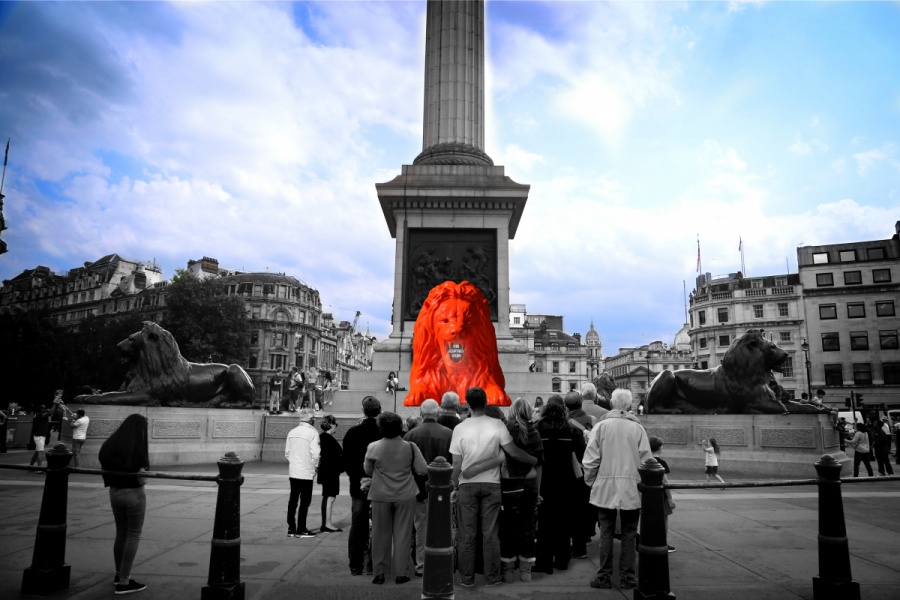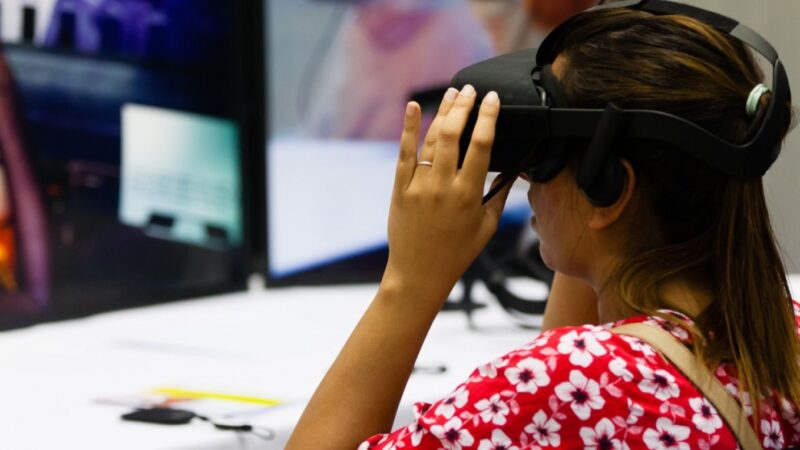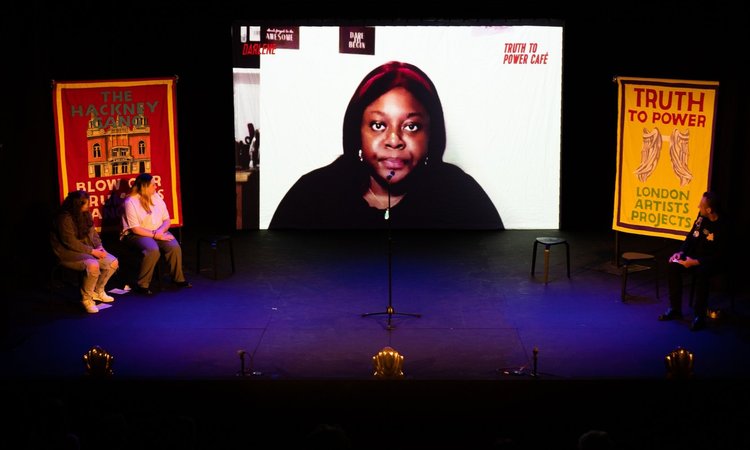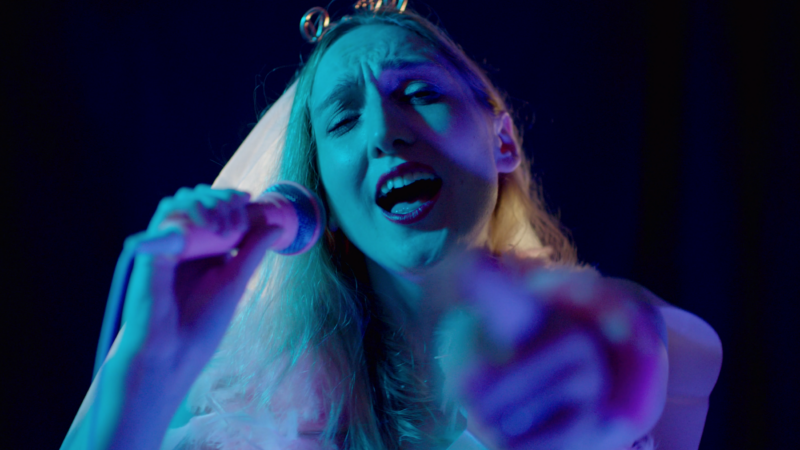How do you connect audiences everywhere with a chance to take part in a collective design installation artwork in Trafalgar Square? In this case study, Es Devlin, the London Design Festival and Google Arts and Culture explain how they used interactive technology to bring a piece of the festival experience to audiences beyond the city’s borders, with help from The Space.
Reconnecting to Landseer’s Lions
Es Devlin is widely recognised to be one of the most visionary and artistically ambitious figures bridging the fields of music, art, theatre and technology today. She is known for creating large-scale performative sculptures and environments that fuse technology and poetry and, in September 2017, Es was walking through Trafalgar Square with Sir John Sorrell, Chairman of the London Design Festival (LDF). They were discussing the history of the square and its long association with major public moments from celebrations to protests, when Sorrell made a chance remark about the lions that have inhabited its imposing plinths since 1867.
“He nudged me and said ‘Landseer never wanted those lions to look so passive. He proposed a much more animated stance, but Queen Victoria found it too shocking,” recalls Devlin.
“The thought lodged in my mind: what if we could invest the lion with a diversely crowdsourced, single collective poetic voice?
“Trafalgar Square is a place many of us stack up memories – it’s like a great corridor of this city. If every time someone walked through the square, they felt linked to all those voices that have been heard since its inception in the 1850s, or if this piece became a sort of hinge that connected them to a deeper understanding of the square and about the city we live in, [I thought] that would be something,” she says
At the time in 2017, Devlin had started exploring and experimenting with AI through a collaboration with Google Arts and Culture, working with creative technologist Ross Goodwin. This began through a conversation with Hans Ulrich Obrist, leading to an installation titled PoemPortraits, at the Serpentine Galleries Summer Party 2017 – guests were invited to donate a word and become part of a transient social sculpture; their word extended into a line of poetry by a machine learning algorithm.

With support from Google Arts and Culture Lab, and working closely again with Ross Goodwin, Devlin began to work on Please Feed the Lions, an installation idea that would introduce a new, bright red lion to Trafalgar Square as part of LDF 2018; a lion that would ‘eat’ words submitted by visitors and ‘digest’ them to create a collective poem that evolved and grew over 6 days. The poem would be generated by a machine learning algorithm, displayed to visitors inside the lion’s mouth during the day, and projected onto Nelson’s Column at night.
Meanwhile, Google Arts and Culture would create a parallel online exhibition of content that allowed audiences everywhere to explore the work and the story behind it, where they’d make the full poem available at the end of the six days.
Reaching beyond London
For the Festival team, this was an exciting opportunity for the first major public installation during LDF using Artificial Intelligence (AI), and the potential to attract new audiences to their work through the use of interactive technology.
“It’s the first project of its kind that we’ve worked on,” says Hanna Barber, Partnership Manager at LDF. “We were thrilled that Es wanted to work with us and, from a technological perspective, the project was exciting because it gave us a chance to attract a wider audience.
“But while we’re very used to producing physical installations, working with this kind of technology was a new area for us, so we needed that expertise from our partners.
“It was also about expanding upon our usual global reach – we set it up so that people could feed in a word on our website, meaning the piece had a life in both the physical space and online, and could be experienced by audiences both in London and across the world. For us, that idea of augmenting the Festival in the digital environment was great, and using those new channels enabled us to reach different audiences.”
The Google Arts & Culture Lab also saw the piece as an opportunity to create a different kind of work.
“One of our focus areas is supporting and facilitating experimentation between arts and tech, which this absolutely did,” says Creative Lead Freya Murray. “It explored and experimented with AI in a creative context, and we were excited by that. It was also the first time we had worked on a physical, public artwork on this scale powered by AI: It explored and experimented with AI in a creative context, a tool that enabled Ed’s vision to be realised.
“Supporting access to arts and culture is a big part of what we do, and this was a really accessible artwork – it allowed people to have both an individual and a collective experience, and to engage with an iconic part of London in a new and playful way.
“And what we found was that it wasn’t just one type of person who engaged with it, but a really broad audience. It was a great way to reach beyond LDF’s regular visitors, because it was also about passers-by, and how you engage people in that way.”
When Murray approached The Space to come on board to support with digital production and the development of a digital engagement plan, it was the rich story behind the piece – and Google Arts and Culture’s plans to give it an online life beyond the festival – that convinced them to get involved.
“The narrative concept and subject matter around it, and Es’ beautiful way of articulating that, were what we were most interested in supporting,” says Executive Producer Sarah Toplis. “We wanted to bring more people to that by helping LDF to reach beyond their core audiences, as well as supporting them to build capacity to create their first digital work. We worked with them to look at how the public were going to interact with the piece, and what the digital and social engagement plans were going to be.”
“We don’t do many site-specific projects but we are always looking for the right ones. For us, it’s often about whether there is an online element that allows the piece to live on online, so that more people will be able to engage with it.”
Engaging the audience
A key factor in the piece’s ability to engage an audience lay in the physical design of the installation itself.
Devlin explains how this informed the design process. “Using a lidar scanner, we created a precise model of one of the original lions, but we manipulated the mouth open, and put a screen in there, that so that during the day, when you approached the lion, you were invited to feed it a word,” she says. “Then it spoke back, load and roaring, giving you a two-line verdict on your choice.”
“We wanted to cut through the grey of London, so it had to be fluorescent. I hoped that an unsuspecting passer-by or tourist might actually think that someone had come and dipped Trafalgar Square’s fifth lion in several cans of red-orange spray paint.”
“At night, the text ricocheted from the lion in projection mapping and then ran up Nelson’s Column, creating a real beacon for people to take part.”
Sarah Toplis adds that the sound design also played a big part in engaging passers-by.
“The roar was really resonant in Trafalgar Square,” she recalls. “When the projections weren’t running in the full light, it was the roar that drew your attention; the sound effects drew you in, and grew as the interactions triggered sounds.”
Then there was Goodwin’s development of the algorithm that would drive the interaction. Because Devlin’s vision was to create a work that connected people to the Square’s history, he trained the algorithm on a vast library of 19th century poetry books – each time a word was fed to the lion, the algorithm would reference this library to predict the next character of the phrase, over and over, until it had generated two lines of new verse sparked by the submitted word, effectively connecting the contributions of present-day visitors to the voices of poets who were writing when the Lions were created 150 years ago.
Each of these elements came with their own challenges. As the designer of the installation, Devlin’s main concerns were around people’s reaction to the concept:
“I was really sensitive to the criticism that I knew was going to be levelled at it, people saying: “why didn’t you just get a poet?” or “why do you need machine learning and algorithms?” she says.
“There is always going to be this question about the extent to which machine learning and algorithms can augment human capacities, and not replace them. My answer is that no one is suggesting that there shouldn’t be human poets; we’re just saying that if you walk into Trafalgar Square and you weren’t about to write a poem, you can take part in one.”
For Goodwin, the main challenge was technical. “The biggest issue was finding an approach that I was confident enough about,” he says. “With PoemPortraits, we didn’t really worry as much about bad words. In this case, it’s a different context, because people were submitting words that would be projected on a very public surface, and at a very large scale.”
Names, too, proved problematic – when testing the algorithm, the team found that submitting their own names interrupted the natural flow of the poem.
Both issues were resolved by adding a system that allowed the lion to filter names and inappropriate contributions, but it was important that this was done in a way that maintained the storytelling experience.
Meanwhile, Murray was keen to manage the visitor experience so that visitors wouldn’t have to wait long to submit their words:
“I was concerned about there being really long lines,” she says. “And yes, there was a queue, but what was great to see was that people were really taking delight in just seeing what other people were contributing, and what poems their words created; I actually think it was that collective experience that worked so well.”
Telling the world
Choosing which online platforms to promote and publicise the piece on was another key consideration. LDF focused on making the interactive element of the installation available through its own channels.
“Visitors could ‘feed’ the lion with words via our website, and our online comms activity was complemented by content on Google and The Space’s channels,” explains Barber.
To drive awareness and interaction, The Space worked with LDF to develop a digital engagement plan, with a particular focus on using the Festival’s social media channels to engage new audiences and grow their social following.
As part of this, Head of Distribution Sarah Fortescue and associate Mel Spencer developed a social marketing plan for the piece, and supported LDF with the creation and seeding of social content, including a Facebook Live that captured the lion in action in Trafalgar Square. They also provided help with planning and setting up promoted social activity that targeted the periphery of LDF’s audience.
For Google Arts and Culture, the focus was on preserving the piece through the online exhibition.
“We scanned the lion in the Square, then captured the whole area in 360, so now we have a digital version preserved,” explains Murray.
“With promotion, it was a joint effort across all our channels – we created a trailer, social content, and a documentary, and communicated the project across the Google Arts and Culture and Google UK social platforms.”
This ‘divide and conquer’ approach proved to be an effective one: “Our ambitions were always to try and broaden the audience outside of London, and for something to live on in the digital world, and we managed to achieve that,” says Barber.
“Working with The Space and with Google really helped us to optimise the digital potential of the activity; so many of the words that were fed in actually came from outside the physical site itself, so that shows that people really were engaging, not just by going to the installation but also, if they weren’t able to physically be there, by interacting online.”
Over the course of the installation, almost 50,000 visitors submitted words to the lion.
“There was a constant stream of interaction – people were inputting words from the moment it opened to the moment it finished,” says Toplis.
The piece was also seen by 240,000 visitors to the square – success that Barber attributes to its attention-grabbing design:
“We wanted to create an impactful and newsworthy visual moment, and I think we certainly achieved that; for anyone who passed Trafalgar Square, it was hard to miss!”
In terms of audience development, the rewards of extending the piece’s reach online were significant. LDF notes in its evaluation that nearly half the visitors feeding words into the algorithm submitted them online, and that online engagement with the piece spanned a far broader audience, in terms of both geography and demographics.
Meanwhile, the social activity around the installation garnered over 50,000 active engagements across Facebook, Instagram and Twitter (video views of over 10 seconds, shares, likes etc.) and contributed to a 5.4% growth in LDF’s social following over the festival period, with its Instagram channel posting an impressive 12% jump in followers.
Following this success, LDF is exploring opportunities to trial new areas of innovation such as VR, AR or streaming content.
We might not have seen the last of the Lion, either.
Top tips for projects using interactive tech
1. Consider the story. The tech shouldn’t be the vision for the work, but part of the story – a way of getting people involved. “One thing that was central to the success of this piece was joining the dots between the physical on-site experience, and the online experience,” says Toplis. “With any interactive project, it’s important to think about how you’ll use the narrative to make it a whole, coherent piece for an audience.”
2. Be focused. “Instead of getting involved in exploring all the possible things you can do with different technologies, it often works best to concentrate on the element that will help you deliver your vision, and make sure that’s really robust,” says Google’s Murray. “It’s better to have one technical aspect, which you’re 100 per cent confident in, than to have multiple different technologies involved that could potentially dilute the experience.”
3. Get the right timeframe and expertise in place. LDF advise anyone planning an interactive project to start as early as possible, and to bring on board experts and specialists who can look after the technical/digital components.
4. Beware of the basics. “There’s always a risk, with anything technical, that the technology will fail, and it’s often the most basic things – like power supplies – that go wrong,” says Murray. For Please Feed the Lions, the team contracted a technical partner to remain on site to monitor all the essentials.
5. Test, test, test. Murray stresses that a robust testing process was absolutely crucial to refining the algorithm. “We ran lots of tests with different words to check that we were happy with the poetry that was being produced,” she says. “Once it goes live, you have no control, so that process was really important.”
Find out more
Explore the Please Feed the Lions online exhibition on the Google Arts and Culture pages at https://artsandculture.google.com/project/please-feed-the-lions
About the artists
Es Devlin
Es Devlin is an artist and designer whose practice ranges from solo gallery works to collaborations in opera, dance, concerts and theatre. She has created stage sculptures in collaboration with Beyonce, Kanye West, U2, Jay Z, Adele and The Weeknd. She designed the London Olympic closing ceremony and the Rio Olympic opening ceremony and continues to work in theatre at all scales – including Hamlet with Benedict Cumberbatch at the Barbican and Girls & Boys with Carey Mulligan at the Royal Court. www.esdevlin.com
Ross Goodwin
Ross Goodwin is an Artist, Creative Technologist for AMI at Google Arts & Culture, hacker, gonzo data scientist, writer of writers. He is a Graduate of NYU ITP & MIT, and a former Obama administration ghostwriter. He employs machine learning, natural language processing and other computational tools to realize new forms and interfaces for written language. www.rossgoodwin.com
About the partners
London Design Festival
Established in 2003 by Sir John Sorrell CBE and Ben Evans, London Design Festival celebrates and promotes London as the design capital of the world and as the gateway to the international design community. London Design Festival has since earned the reputation as a key calendar moment of London’s autumn creative season, alongside London Fashion Week, Frieze Art Fair and the London Film Festival, attracting the greatest thinkers, practitioners, retailers and educators to the capital, in a citywide celebration. www.londondesignfestival.com
Google Arts and Culture
Discover the inspirational moments, iconic people, and artistic wonders that are available at the tip of your fingers. Google Arts & Culture allows you to immerse yourself in culture with 360 views, zoom in to reveal the secrets of a masterpiece, take behind the scenes tours of palaces and museums, watch kids explain famous paintings to art experts, and so much more. Art changes the way we see the world and the way we see each other, so we invite you to come and expand your horizons with us. https://g.co/artsandculture
How useful was this resource?




